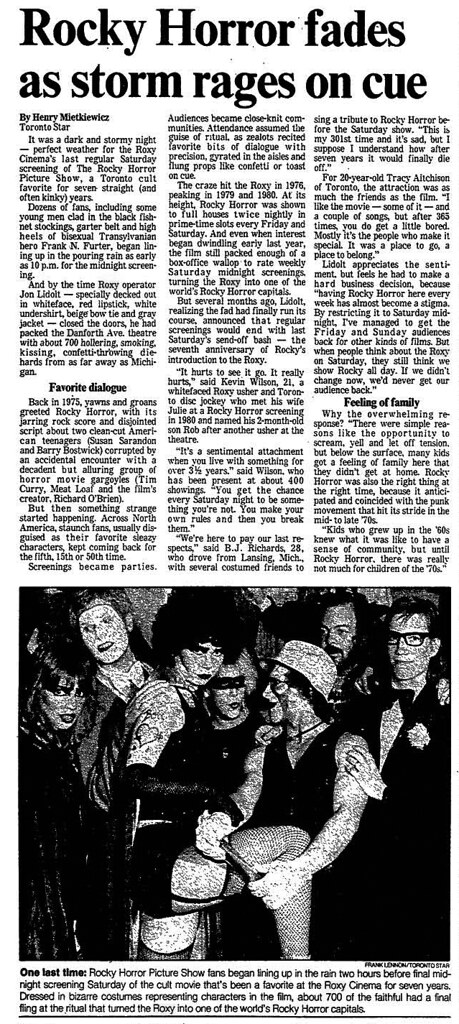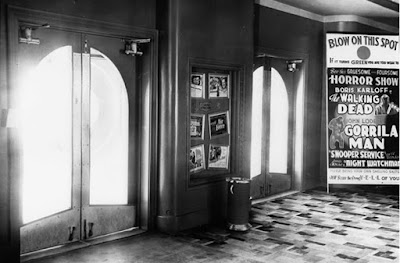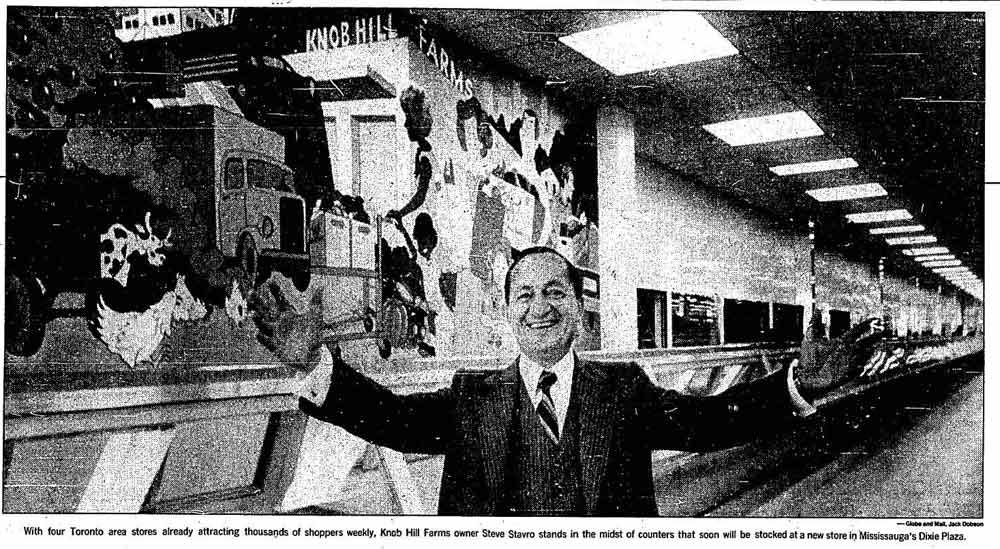This installment of my "Ghost City" column for The Grid was originally published on October 23, 2012.
A suggestion for anyone hitting the town in their best
Rocky Horror Picture Show finery this Halloween: Make a pit stop at the
Esso/Tim Horton’s at Danforth and Greenwood. Walk through the restored front doors underneath the marquee of the old Allenby theatre. Buy some snacks to fuel an evening of time-warping. Take a look at the old ads in the showcase by the front doors and take a moment to pay tribute to the place where the movie became a Toronto cult favourite.
 |
| Toronto Star, May 9, 1983. Click on image for larger version. |
Debuting at what was then known as the
Roxy in May 1976,
Rocky Horror showings reached their peak in 1980, when audiences performed their routines twice a night on Fridays and Saturdays. The screenings drew a devoted following, with participants driving in from as far as Rochester and central Michigan. Friendships developed, romances blossomed, and some attendees even named their children after the ushers. Parties celebrating the anniversary of the first screening turned into grand occasions for fans—during a fifth-anniversary party, Debra Yeo and her friends rented a limo to take them from Castle Frank station (intentionally chosen as a play on Frank-N-Furter’s castle) to the Roxy where, she later recalled in the
Star, “we confounded Jeanne Beker and a NewMusic film crew when they realized we weren’t VIPs.”
 |
| Toronto Star, June 17, 1936. |
Toilet paper wasn’t thrown down the aisles when the Allenby opened at what was then 1215 Danforth Avenue on June 18, 1936. Built by theatre architects
Kaplan and Sprachman, opening ads claimed the Art Deco-inspired cinema offered “the newest in luxurious equipment” and was “scientifically air conditioned.” It remained a first-run theatre until 1970 when, renamed the Apollo, it switched to Greek films. Within months, it changed name and format again to become the Roxy rep house.
When a plan to run five months of top-quality Japanese films flopped, programming was handed over to three young film buffs, Robert Buchanan, Neil McCarthy, and Gary Topp. Billed as “The Original 99 Cent Roxy,” the theatre offered art films and classic double-bills that brought in older customers during the week, and rock-music films greeted with cheers by younger audiences on weekends. Live novelty acts were mixed in, such as a pianist who attempted to play for 110 hours straight.
 |
| Toronto Star, October 20. 1973. Click on image for larger version. |
That vibe continued when Jon Lidolt took over programming in 1976. Under his watch, the theatre became one of the first in Canada to be equipped with a Dolby sound system. Besides
Rocky Horror, the theatre frequently showed Led Zeppelin’s
The Song Remains the Same. Midnight screenings of any film were accompanied by a haze of pot smoke. “The sweet smell gives the place a distinctive atmosphere,” the
Star observed in 1977, “and the high sharpens the audience’s willingness to burst out in laughter or scream as some arch villain does his dirty work.”
 |
| Toronto Star, April 6, 1993. Click on image for larger version. |
After a brief spell as part of the Festival rep chain, the building was sold in 1987. The new owners turned the theatre into an after-hours club, which raised the ire of neighbours and police. While operating as the Hollywood Dinner Theatre, the site was host to 70 major incidents that required police attention between 1990 and 1993. Beyond infractions for drug dealing, teenage prostitution, and selling liquor without a licence, there were stabbings and shootings. One of the most gruesome incidents occurred in March 1992, when a pair of 15-year olds was arrested for partly scalping one teen and slicing the ear of another in half. Residents overcame their fears of recrimination and convinced City Council to unanimously pass a motion recommending to the Ontario Liquor Control Board that any future attempts to secure a liquor licence were not in the public interest.
Apart from brief periods as an Indian theatre and banquet hall decorated with air-brushed homages to Indiana Jones and
Star Wars, the building remained vacant until it was purchased by Imperial Oil in 2006. As the site was on the City’s heritage inventory, the gas giant contacted historical property conversion specialists
E.R.A. Architects. Rather than just preserve the façade, elements like the marquee and ticket booth
from the Allenby days were recreated. Restorations were authentic, employing bricks from the original supplier in Pittsburgh and recreating the style of window that would have been used during the 1930s. The neighbourhood welcomed the project as an opportunity to spark a community revival, hoping that a touch of time-warp would redeem its reputation as a rough stretch of the Danforth.
Additional material from the October 14, 2010 edition of the Globe and Mail, and the June 17, 1936, October 20, 1973, January 22, 1977, May 9, 1983, April 5, 1993, April 27, 1994, and October 1, 2005 editions of the Toronto Star.








Comments